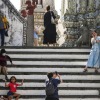Foreign photographers documented scenes of early 20th-century southern Vietnam, including images of students from the Marie Curie private girls’ school and crowds enjoying traditional opera performances.
 |
|
The street in front of the HCMC Opera House at the turn of the 20th century. The building, designed by Félix Olivier, was inspired by the Palais Garnier in Paris, France. It was built in 1900, with most of the decorative elements and building materials sourced from France. A series of these photographs is featured in the book “Urban Architecture and Landscape of Saigon – Cho Lon (a Saigon neighbourhood with a heavy Chinese influence) Past and Present,” published by the HCMC General Publishing House in July. The work, by Nguyen Duc Hiep, Tim Doling and Vo Chi Mai, includes images gathered from magazines and other sources from the early 20th century. The authors, who have extensively studied the history and culture of the city and have served as cultural advisors to UNESCO, have previously released several publications about the Saigon – Gia Dinh – Cho Lon area. |
 |
|
People strolling outside the Opera House. Over 100 years ago the Opera House and its surrounding areas were popular venues for cultural and artistic events. Today it continues to host many significant city events. |
 |
|
Students at Marie Curie School at dismissal time. Established in 1918, the school was initially called the French Girls’ Primary School (EPS des J.F. Francaises), teaching only in French to French girls and a few wealthy Vietnamese girls from privileged families. |
 |
|
Citizens eagerly watch hat boi, also known as Vietnamese classical opera. |
 |
|
Ohier Street (now Ton That Thiep Street, District 1) in photographs in the 1920s. |
 |
|
Binh Tay Market in District 6 in the early 20th century seen from the Binh Tay Bridge. |
 |
|
Binh Tay Bridge over the Tau Hu Canal, connecting Binh Dong Pier and Binh Tay Market, was initially wooden but later replaced with an iron structure. |
 |
|
The inauguration of Binh Tay Market in 1928. |
 |
|
The Quai de Mytho area (My Tho port), now Vo Van Kiet Boulevard, District 5. To the left is the Saigon – Cho Lon railway line and the Saigon – My Tho telegraph pole. |
 |
|
Thien Hau Temple in the 1920s. This 200-year-old place on Nguyen Trai Street, District 5, now attracts many tourists. |
 |
|
The villa of Governor General Phuong (Do Huu Phuong), a notably wealthy figure in Southern Vietnam at the end of the 19th and early 20th centuries. Chau Van Liem Street (District 5) was named after him until 1975 and subsequently renamed. |
 |
|
The garden inside the villa of Governor General Phuong (Do Huu Phuong), a well-known wealthy figure in southern Vietnam in the late 19th – early 20th century). Nguyen Duc Hiep, representing the book’s authors, aims for the work to guide readers through the cultural, social, and architectural landscape of southern Vietnam from the late 19th century to modern-day Ho Chi Minh City. |
Photos provided by Ho Chi Minh City General Publishing House.
- Reduce Hair Loss with PURA D’OR Gold Label Shampoo
- Castor Oil Has Made a “Huge” Difference With Hair and Brow Growth
- Excessive hair loss in men: Signs of illness that cannot be subjective
- Dịch Vụ SEO Website ở Los Angeles, CA: đưa trang web doanh nghiệp bạn lên top Google
- Nails Salon Sierra Madre
 VnExpress News The News Gateway of Vietnam
VnExpress News The News Gateway of Vietnam





